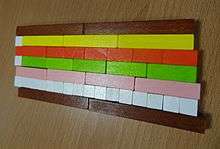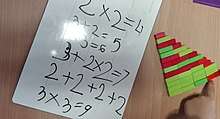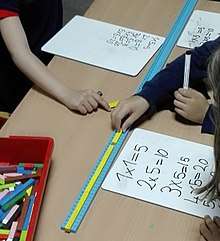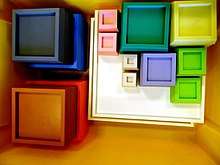Cuisenaire rods
Cuisenaire rods are mathematics learning aids for students that provide an interactive, hands-on[1] way to explore mathematics and learn mathematical concepts, such as the four basic arithmetical operations, working with fractions and finding divisors.[2][3] In the early 1950s, Caleb Gattegno popularised this set of coloured number rods created by the Belgian primary school teacher Georges Cuisenaire (1891–1975), who called the rods réglettes.
According to Gattegno, "Georges Cuisenaire showed in the early 1950s that students who had been taught traditionally, and were rated ‘weak’, took huge strides when they shifted to using the material. They became 'very good' at traditional arithmetic when they were allowed to manipulate the rods."[4]
History
The educationalists Maria Montessori and Friedrich Fröbel[5] had used rods to represent numbers, but it was Georges Cuisenaire who introduced the rods that were to be used across the world from the 1950s onwards. In 1952 he published Les nombres en couleurs, Numbers in Color, which outlined their use. Cuisenaire, a violin player, taught music as well as arithmetic in the primary school in Thuin. He wondered why children found it easy and enjoyable to pick up a tune and yet found mathematics neither easy nor enjoyable. These comparisons with music and its representation led Cuisenaire to experiment in 1931 with a set of ten rods sawn out of wood, with lengths from 1 cm to 10 cm. He painted each length of rod a different colour and began to use these in his teaching of arithmetic. The invention remained almost unknown outside the village of Thuin for about 23 years until, in April 1953, British mathematician and mathematics education specialist Caleb Gattegno was invited to see students using the rods in Thuin. At this point he had already founded the International Commission for the Study and Improvement of Mathematics Education (CIEAEM) and the Association of Teachers of Mathematics, but this marked a turning point in his understanding:
Then Cuisenaire took us to a table in one corner of the room where pupils were standing round a pile of colored sticks and doing sums which seemed to me to be unusually hard for children of that age. At this sight, all other impressions of the surrounding vanished, to be replaced by a growing excitement. After listening to Cuisenaire asking his first and second grade pupils questions and hearing their answers immediately and with complete self-assurance and accuracy, the excitement then turned into irrepressible enthusiasm and a sense of illumination.[6]
Gattegno named the rods "Cuisenaire rods" and began trialing and popularizing them. Seeing that the rods allowed students "to expand on their latent mathematical abilities in a creative and enjoyable fashion", Gattegno's pedagogy shifted radically as he began to stand back and allow students to take a leading role:

Cuisenaire's gift of the rods led me to teach by non-interference making it necessary to watch and listen for the signs of truth that are made, but rarely recognized.[6]
While of course the material has found an important place in myriad teacher-centered lessons, Gattegno's student-centered practice inspired a number of educators. The French-Canadian educator Madeleine Goutard in her 1963 Mathematics and Children, wrote:
The teacher is not the person who teaches him what he does not know. He is the one who reveals the child to himself by making him more conscious of, and more creative with his own mind. The parents of a little girl of six who was using the Cuisenaire rods at school marveled at her knowledge and asked her: 'Tell us how the teacher teaches you all this', to which the little girl replied: 'The teacher teaches us nothing. We find everything out for ourselves.'[7]
John Holt, in his 1964 How Children Fail, wrote:
This work has changed most of my ideas about the way to use Cuisenaire rods and other materials. It seemed to me at first that we could use them as devices for packing in recipes much faster than before, and many teachers seem to be using them this way. But this is a great mistake. What we ought to do is use these materials to enable children to make for themselves, out of their own experience and discoveries, a solid and growing understanding of the ways in which numbers and the operations of arithmetic work. Our aim must be to build soundly, and if this means that we must build more slowly, so be it. Some things we will be able to do much earlier than we used to, fractions for example.
Gattegno formed the Cuisenaire Company in Reading, England in 1954[8] and, by the end of the 1950s, Cuisenaire rods had been adopted by teachers in 10,000 schools in more than a hundred countries.[9] The rods received wide use in the 1960s and 1970s. In 2000, the United States-based company Educational Teaching Aids (ETA) acquired the US Cuisenaire Company and formed ETA/Cuisenaire to sell Cuisenaire rods-related material. In 2004, Cuisenaire rods were featured in an exhibition of paintings and sculptures by New Zealand artist Michael Parekowhai.
Rods
| Colour | Common abbreviation |
Length (in centimetres) |
|---|---|---|
| White | w | 1 |
| Red | r | 2 |
| Light green | g | 3 |
| Purple (or pink) | p | 4 |
| Yellow | y | 5 |
| Dark green | d | 6 |
| Black | b | 7 |
| Brown (or "tan") | t | 8 |
| Blue | B | 9 |
| Orange | O | 10 |
Another arrangement, common in Eastern Europe, extended by two large (10+ cm) sizes of rods, is the following:
| Colour | Length (in centimetres) |
|---|---|
| White | 1 |
| Pink | 2 |
| Light blue | 3 |
| Red | 4 |
| Yellow | 5 |
| Purple | 6 |
| Black | 7 |
| Brown | 8 |
| Dark blue | 9 |
| Orange | 10 |
| Green | 12 |
| Tan | 16 |

Use in mathematics teaching
The rods are used in teaching a variety of mathematical ideas, and with a wide age range of learners.[10] Topics they are used for include:[10]
- Counting, sequences, patterns and algebraic reasoning
- Addition and subtraction (additive reasoning)
- Multiplication and division (multiplicative reasoning)
- Fractions, ratio and proportion
- Modular arithmetic leading to group theory
The Silent Way
Though primarily used for mathematics, they have also become popular in language-teaching classrooms, particularly The Silent Way.[11] They can be used
- to demonstrate most grammatical structures such as prepositions of place, comparatives and superlatives, determiners, tenses, adverbs of time, manner, etc.,
- to show sentence and word stress, rising and falling intonation and word groupings,
- to create a visual model of constructs, for example the English verb tense system [12]
- to represent physical objects: clocks, floor-plans, maps, people, animals, fruit, tools, etc. which can lead to the creation of stories told by the students as in this video.[13]
Other coloured rods


In her first school, and in schools since then, Maria Montessori used coloured rods in the classroom to teach concepts of both mathematics and length. This is possibly the first instance of coloured rods being used in the classroom for this purpose.
Catherine Stern also devised a set of coloured rods produced by staining wood with aesthetically pleasing colours, and published books on their use at around the same time as Cuisenaire and Gattegno.[14][15] Her rods were different colours to Cuisenaire's, and also larger, with a 2 cm unit cube rather than 1 cm. She produced various resources to complement the rods, such as trays to arrange the rods in, and tracks to arrange them on. Tony Wing, in producing resources for Numicon, built on many of Stern's ideas, also making trays and tracks available for use with Cuisenaire rods.[16]
In 1961 Seton Pollock produced the Colour Factor system,[17] consisting of rods from lengths 1 to 12 cm. Based on the work of Cuisenaire and Gattegno, he had invented a unified system for logically assigning a color to any number. After white (1), the primary colors red, blue and yellow are assigned to the first three primes (2, 3 and 5). Higher primes (7, 11 etc.) are associated with darkening shades of grey. The colors of non-prime numbers are obtained by mixing the colors associated with their factors – this is the key concept. A patent is registered in Pollock's name for an "Apparatus for teaching or studying mathematics"[18]. The aesthetic and numerically comprehensive Color Factor system was marketed for some years by Seton Pollock's family, before being conveyed to Edward Arnold, the educational publishing house. The colors of Pollock's system were named distinctively using, for example, 'scarlet' instead of 'red', and 'amber' instead of 'orange'. They are listed below[19].
| Colour | Length |
|---|---|
| White | 1 |
| Pink | 2 |
| Light Blue | 3 |
| Scarlet | 4 |
| Yellow | 5 |
| Violet | 6 |
| Grey | 7 |
| Crimson | 8 |
| Royal Blue | 9 |
| Amber | 10 |
| Dark Grey | 11 |
| Mauve | 12 |
See also
References
- "Cuisenaire® Rods Come To America". Etacuisenaire.com. Archived from the original on 2013-01-23. Retrieved 2013-10-24.
- Gregg, Simon. "How I teach using Cuisenaire rods". mathagogy.com. Archived from the original on 13 September 2014. Retrieved 22 April 2014.
- "Teaching fractions with Cuisenaire rods". Teachertech.rice.edu. Retrieved 2013-10-24.
- Gattegno, Caleb. The Science of Education Part 2B: the Awareness of Mathematization. ISBN 978-0878252084.
- Froebel Web. "Georges Cuisenaire created numbers in color". Froebelweb.org. Retrieved 2013-10-24.
- Gattegno, Caleb (2011). For the Teaching of Mathematics Volume 3 (2nd ed.). Educational Solutions. pp. 173–178. ISBN 978-0-87825-337-1. Retrieved 28 October 2016.
- Goutard, Madeleine (2015). Mathematics and Children (2nd ed.). Reading: Educational Explorers Limited. p. 184. ISBN 978-0-85225-602-2. Retrieved 28 October 2016.
- "About Us". The Cuisenaire® Company. Retrieved 28 October 2016.
- "Association of Teachers of Mathematics Honours Dr. Caleb Gattegno at Annual Conference", Associated Press, April 14, 2011, archived from the original on June 10, 2014, retrieved January 2, 2014
- Gregg, Simon; Ollerton, Mike; Williams, Helen (2017). Cuisenaire – from Early Years to Adult. Derby: Association of Teachers of Mathematics. ISBN 978-1-898611-97-4. Retrieved 3 October 2017.
- "Beginner Silent Way exercises using Cuisenaire rods". glenys-hanson.info. Archived from the original on 2016-03-04. Retrieved 2015-04-25.
- "English Verb Tenses: a dynamic presentation using the Cuisenaire Rods". glenys-hanson.info. Archived from the original on 2016-03-16. Retrieved 2015-04-25.
- "Silent Way: rods, describing a scene (part 6 of 8)". YouTube. 2010-04-11. Retrieved 2013-10-24.
- "Stern Math: A Multisensory, Manipulative-Based, Conceptual Approach". Sternmath.com. Retrieved 2016-05-24.
- "Stern Math: About the Authors". Sternmath.com. Retrieved 2016-05-24.
- Wing, Tony (1 December 1996). "Working towards mental arithmetic... and (still) counting". Mathematics Teaching (157): 10–14.
- "ColorAcademy 2005 - Mathematics & Measurement". ColorAcademy. 2004. Archived from the original on 2016-04-12. Retrieved 2016-05-24.(brief overview of the history of Colour Factor)
- "Apparatus for teaching or studying mathematics". United States Patent Office. 1965. Retrieved 2020-02-05.
- Ewbank, William A. (1978). "The Use of Color for Teaching Mathematics". The Arithmetic Teacher. National Council of Teachers of Mathematics. 26 (1): 53–57. JSTOR 41190497.
Further reading
- Cuisenaire Rods in the language classroom – article by John Mullen
- Maths with Rods - 40 exercise tabs to play with parents – downloadable book with Creative Commons License
- Learn Fractions with Cuisenaire Rods. Introduction
External links
| Wikimedia Commons has media related to Cuisenaire rods. |
- A 1961 film from the National Film Board of Canada. Caleb Gattegno conducting a demonstration lesson with Cuisenaire rods: In 3 parts on YouTube
- Online Cuisenaire rods (NumBlox Freeplay)
- The Cuisenaire Company - registered UK trademark holder, with background to Cuisenaire and Gattegno.
- La méthode Cuisenaire - Les nombres en Couleurs - site officiel (in French)
- History of the number rods from 1806 to 2020 (in french).